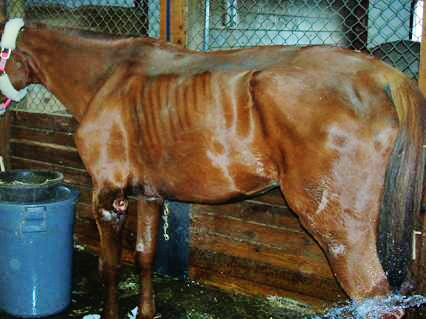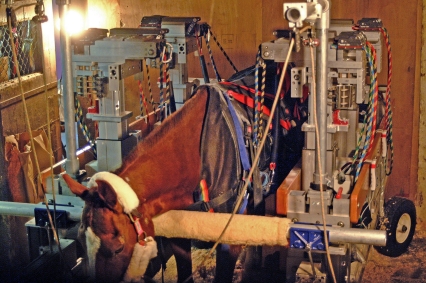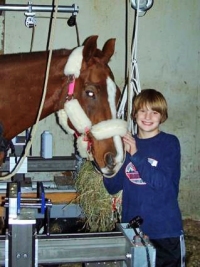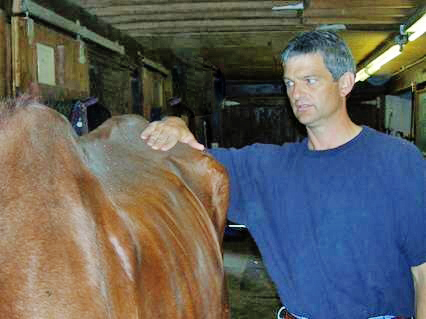|
By Kathleen A. Reagan, Esq.
I want to share what started off as a heart-breaking story about my fifteen year old, argentine thoroughbred, polo pony, Bandito.
He might have been Kipling's horse, "the Maltese Cat", in a prior life, so steady and companionable has he been since I've had him.
He's a chestnut with lots of "chrome"" as the racing folk say, very nimble, with a chatty personality and great patience for beginning riders.
I, and everyone who knows him, were devastated when he went downhill into laminitis three weeks ago, triggered by an unknown toxicity, we think.
I had no idea there was such a thing as "sinking" laminitis, where the horse's feet try to shuck right off, with the meat of the foot separating from the hoof wall at the coronet band through the progression of the disease.
Bandito went down, and got up only with difficulty and with great pain.
Right before our eyes he was quickly losing weight — he lost two to three hundred pounds over a two-week period.
He developed deep bone sores over his elbows, and other gashes and gouges all over his head and hips from his falls to the ground.
We kept him in a deeply bedded stall, but even that seemed to do little good.
I think my vet (Dr. Conrad Jones of Oceanside Equine in Wakefield, RI) was preparing me for the worst when I suggested to him that we should approach someone I'd met at a horse tradeshow in Hartford, CT, the president of a company that has developed a device to help in the healing of horses with foot problems.
Originally designed for people recovering from injuries that prevented them from bearing weight on their legs and feet over a long term, they've adapted this device for horses so each individual hoof can be off-weighted independently as needed.
Fortunately, a prototype of the equine version of the device was not far from where Bandito is boarded.
This thing is so new it hasn't yet been tested for equine rehabilitation purposes, though it has been successfully tested for equine surgical recoveries.
The name is apropos to Bandito's condition: the Enduro NEST.
The president of Enduro Medical Technology, Ken Messier's answer was positive, and the veterinarian where the prototype was located, Dr. Michael Stewart of River Meadow Farm in Windsor, CT, said it was important to bring Bandito as soon as possible.
Upon Bandito's arrival, Dr. Stewart was shocked at his condition when we got him off the trailer on Wednesday, November 5, 2008.
He later told me that if the NEST had not been available, he would have euthanized Bandito immediately.
Dr. Stewart got Bandito into the NEST, which has a mesh-blanket harness which forms an easy take-on, take-off sling, and brought his front feet off the ground very slightly.
Bandito immediately fell into a deep sleep lasting forty five minutes.
Dr. Stewart later said he suspected the relief from pain must have been so great that it knocked him out, because the mild sedative he'd given him would not have had that effect.

|
|
Notice how thin Bandito is and the pressure sore on his elbow shortly after arriving at River Meadow Farm.
Due to pain from pressure on his laminitic feet, he has been lying down trying to recover.
But that has caused his elbow sore and has limited his ability to eat due to pressure on his internal organs caused by lying down.
Unlike foals, adult horses get too heavy to lie down for more than a short time because their bulk causes too much pressure on their organs to be able to sustain that posture for long.
|
After Bandito awakened, he started eating — he has not stopped.
He eats whatever is put in front of him, without stopping, until it's gone.
He now drinks water at a normal rate and is having no problems dealing with all that food and drink — he is bright eyed and interactive.
But the most interesting part of all of this is the way he's been using the NEST: he treats it like a giant Barcalounger.

|
|
Bandito being supported by the NEST device.
|
When Bandito sees something that interests him, he stands up and supports his own weight on his feet and looks at whatever it is.
Then, when satisfied, he sinks down into the NEST, picks up his feet, and reclines, just like a man reaching for the remote.
He sleeps, eats, drinks and eliminates all that food and drink as it's processed.
He watches barn life and is not being sedated or given any pain medication, and does not appear to want it either.
His pressure sores are healing, and he's not developing any more sores.
Enduro's president has mentioned that he's spoken to a lot of veterinarians that have looked him straight in the eye and told him this approach would never work.
Perhaps, this is because veterinarians are conservative and deeply bound to tradition, and the idea of slinging horses up is a concept that has been repeatedly tried and failed.
The problem seems to be that support in a sling allows a horse's muscles to atrophy and then there's no good way to gradually rebuild that muscle in stages to migrate the horse from the sling back to a healthy condition.

|

Photos by xxxx
|
|
Left: Ken Messier, President of Enduro Medical with Bandito supported by the NEST device.
Right: Helper Clayton with Bandito supported in the NEST device.
|
As I understand it, the NEST concept allows the veterinarian to "dial in" the amount of weight each individual leg of the horse will support.
This approach allows the vet to "rebuild" one or more leg's ability to support weight until the horse can stand and walk on his own.
And in Bandito's case, it is set up to let him stand when he feels he can and wants to do so.
This way, he can also rest in the sling when it becomes painful or tiring to stand.
I'm told that the blanket, mesh harness sling allows his skin to breathe, and that he's essentially "floating" in the sling and can relax into a deep sleep without pressure on his chest or belly and without deteriorating over the long haul while the leg or foot heals.
My research indicates that horse slings have a poor success history and were not much better for the horse than being on the ground and could not sustain him over time.
This is reportedly because all of the horse's weight rested on either his belly, his chest, or his sides, inhibiting breathing, compressing and crushing muscle tissue, and preventing the horse's internal processes from functioning normally while also causing pressure sores to build.
The benefits to the horse's legs and hooves gained from the slings effect of reducing weight were undermined by these "pressure problems".
So, the horse is caught in this "catch 22": if all weight is supported by the sling, then breathing and organ function is compromised.
In addition, leg and hoof muscles atrophy because they support no weight leading to problems when you finally want to let the horse stand on his own in the future.
Without a sling, taking the weight off the injured leg or foot puts that weight on the remaining limbs which are not designed for that additional weight, and therefore, causes problems with them.
The NEST is allowing Bandito to put whatever weight he wants on all three good limbs.
And in his particular case, it's setup to even let him put weight on the lame foot at his discretion, as in when he wants to look up.
This lets him control the pressure on his legs and feet, and also on his chest based on how he feels, and no one knows better than he.
One of my biggest initial concerns was that Bandito could worsen his own condition by "freaking out" because of being constrained within the NEST.
But instead, he's been very calm.
We believe this is because he's able to control his own weight bearing ability and is therefore more at ease with the whole process.
He also hasn't required any sedatives or pain relievers, which concerned me because of the health risks they can bring over the long term.
Surprisingly, Bandito doesn't currently want to get out; yet he's letting the hospital staff know his preferences pretty clearly!
For instance, this past weekend he let them know that he was done with the bungee cords that had previously supported his head.
The most recent picture shows him without them and with an alert look on his face.
I'm praying that this improvement continues.

|
|
Dr. Stewart assessing Bandito's progress.
|
I got a call this morning (11/11/08) with the update that, as unbelievable as it seems after only five and a half days in the NEST, Bandito is starting to re-grow the hoof and the connective tissue inside the hoof.
The hospital staff could see before that he was definitely improving in weight, strength, and in healing of his pressure sores, but the big issue has always been whether he could re-grow those sensitive and delicate tissues inside the hooves.
My fear was that, like a limb, once gone they could not be re-grown.
Well, the word from Dr. Mike is that those areas are mending.
These events with Bandito have changed the way I see the devastating effects of laminitis.
I want to let the world know that we no longer always have to put down horses suffering from this malady — there's hope!
This device has the chance to allow horses to heal themselves from laminitis and many other foot and leg injuries, something that has never been available before.
Bandito and I are in uncharted territory; previously, horses this far gone have euthanized.
I am so happy it appears that Bandito will have a chance to live, run, and play polo with me in the future.
I've included the names of the principals involved in this article so others in the horse industry dealing with similar leg and foot ailments can contact them, and hopefully, use this technology to help their horses mend and live.
And in the interest of full disclosure, I also want you to know that I'm so impressed with this technology that I've invested in the company myself.
Having personally seen the NEST's beneficial effect on Bandito, I believe many horses that have had to be put down in the past, some with well-known names (Barbaro, Eight Belles, etc.) and others like Bandito, might now have a change to heal, live, and run again.
I'll keep you all posted on Bandito's continuing progress.
Editor's Note:This article was written in November 2008.
Unfortunately, Bandito didn't make it, not due to laminitus, but rather to the toxin that originally caused it.
If it wasn't for that, he would have been fine as the laminie was properly re-growing.
You can read the Horse Girl's final posting on this issue at: Bandito.
Kathleen A. Reagan, Esq. is an equine attorney practicing in Braintree, MA, available at www.kathleenreaganlaw.com, has developed a course in equine law at www.concordlawschool.com, and is co-founder and Vice President of QueryHorse, the largest horse information resource on the Internet.
Back to Article Index
|